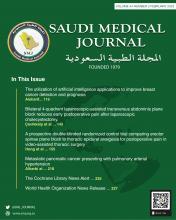Review Article
The utilization of artificial intelligence applications to improve breast cancer detection and prognosis
Alsharif provides insight into the value of artificial intelligent (AI) tools combined with diverse imaging modalities in breast lesion detection and diagnosis. The shift from the conventional computer-aided detection (CAD) system to the advanced AI tools such as DL-CAD has the potential to reduce false-positive findings, increase diagnostic accuracy, improve radiologist performance, and assist with decision-making. Breast imaging faces challenges with the current increase in medical imaging requests and lesions that breast screening programs can miss. Solutions to improve these challenges are being sought with the recent advancement and adoption of artificial intelligent (AI)-based applications to enhance work ow efficiency as well as patient-healthcare outcomes. Using small datasets from the same source may raise concerns regarding the depth, quality, and representativeness of the images that are used to teach the AI-based applications and increase the possibility of bias and overfitting.
see page 119
Original Articles
Bilateral 4-quadrant laparoscopic-assisted transversus abdominis plane block reduces early postoperative pain after laparoscopic cholecystectomy. A prospective, single-blind, randomized study
Çevikkalp et al investigate 40 patients from Private Medicabil Hospital in Turkey the effcacy of bilateral 4-quadrant laparoscopic-assisted transversus abdominis plane (BLTAP) block in laparoscopic cholecystectomy (LC). The 1-hour visual analog scale (VAS) score at rest was lower in the BLTAP block group than in the standard analgesia (SA) and unilateral laparoscopic-assisted transversus abdominis plane (ULTAP) block groups. The change in VAS score was higher in the SA group than in the BLTAP block group. Bilateral 4-quadrant laparoscopic- assisted transversus abdominis plane block technique is more effective than standard analgesia, local anesthetic infiltration, and ULTAP block in preventing early postoperative pain after LC.
see page 145
Doyle’s bulge after the injection of local anesthetic.
A prospective double-blinded randomized control trial comparing erector spinae plane block to thoracic epidural analgesia for postoperative pain in video-assisted thoracic surgery
Hong et al compare 60 patients undergoing video-assisted thoracic surgery (VATS) received patient-controlled thoracic epidural analgesia (TEA) with a basal rate of 3 ml/hour (h), a bolus of 3 ml (Group E), or efficacies of erector spinae plane (ESP) block with programmed intermittent bolus infusions of 15 mL/3 h and a bolus of 5 ml (Group ES) for 2 postoperative days. Patients with continuous ESP block had a higher NRS score than those with TEA but no statistical difference at a specific time. Erector spinae plane block may be inferior to TEA for analgesia following VATS, but it could have tolerable analgesia and a better side effect profile than TEA. Therefore, it could be an alternative to TEA as a component of multimodal analgesia.
see page 155
Care Report
Metastatic pancreatic cancer presenting with pulmonary arterial hypertension
Alharbi et al report a 53-year-old male who was referred to the Pulmonary Medicine clinic for a dry cough for 6 weeks, associated with minimal sputum production which was yellowish in color without blood. Chronic cough is one of the most common symptoms encountered in respiratory clinics. It has a variety of differential diagnoses, and without a clear algorithmic approach, the final diagnosis can be overlooked. This case demonstrate the challenges of diagnosing pulmonary tumor thrombotic microangiopathy despite advancements in diagnostic imaging and the associated high fatality, despite advances in oncological treatments, mostly due to the aggressive behavior of the underlying malignancy and the relatively late diagnosis.
see page 218
Bilateral faint ground glass opacities with tree-in-bud appearance and mild bronchial wall thickening, more pronounced at the right lower lobe.
- Copyright: © Saudi Medical Journal
This is an Open Access journal and articles published are distributed under the terms of the Creative Commons Attribution-NonCommercial License (CC BY-NC). Readers may copy, distribute, and display the work for non-commercial purposes with the proper citation of the original work.








